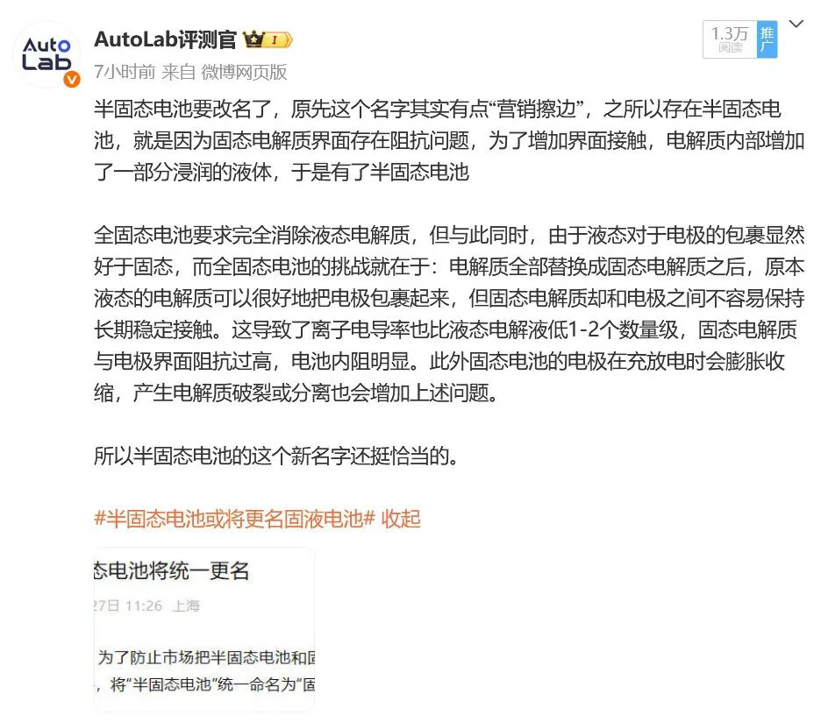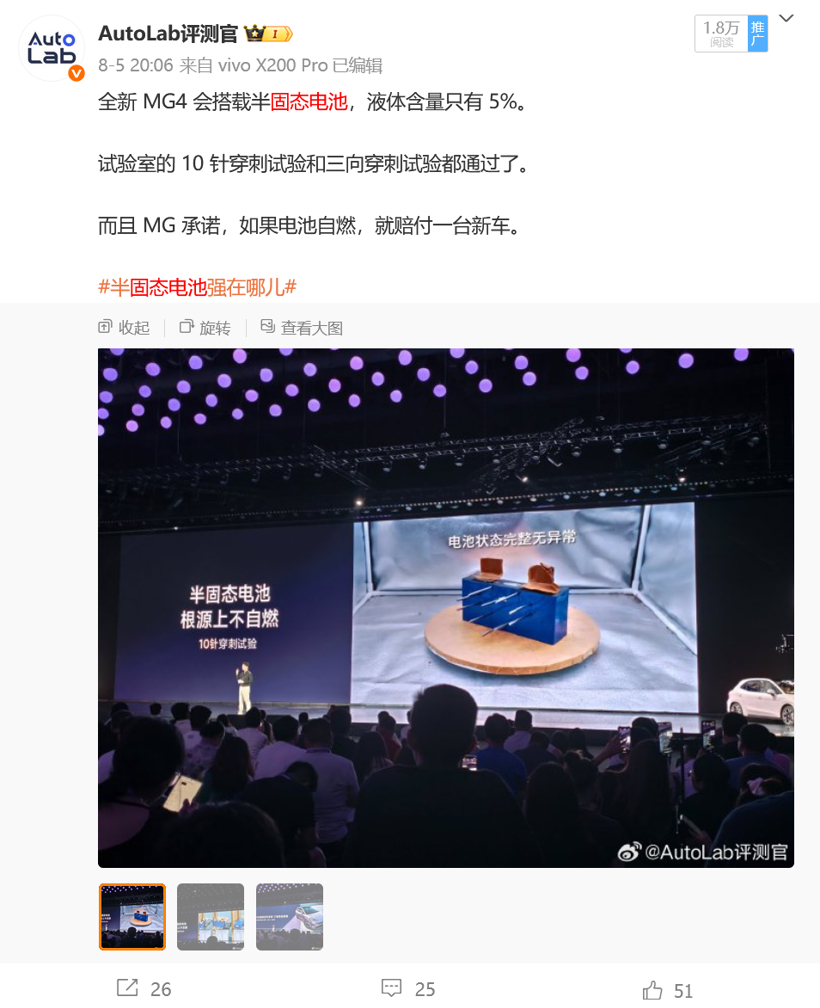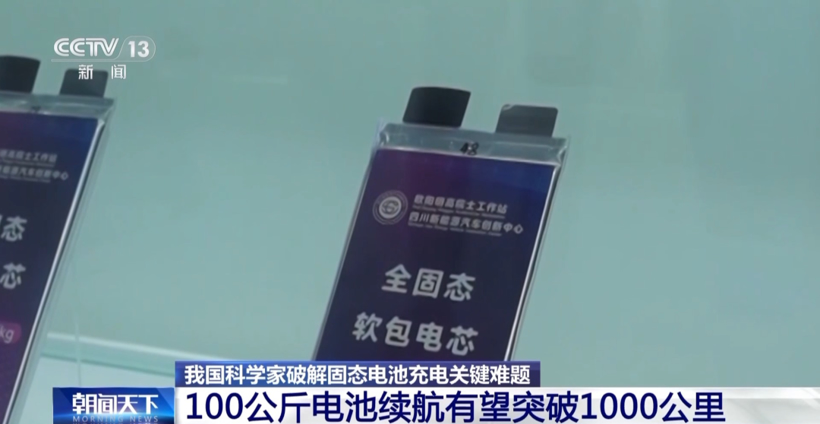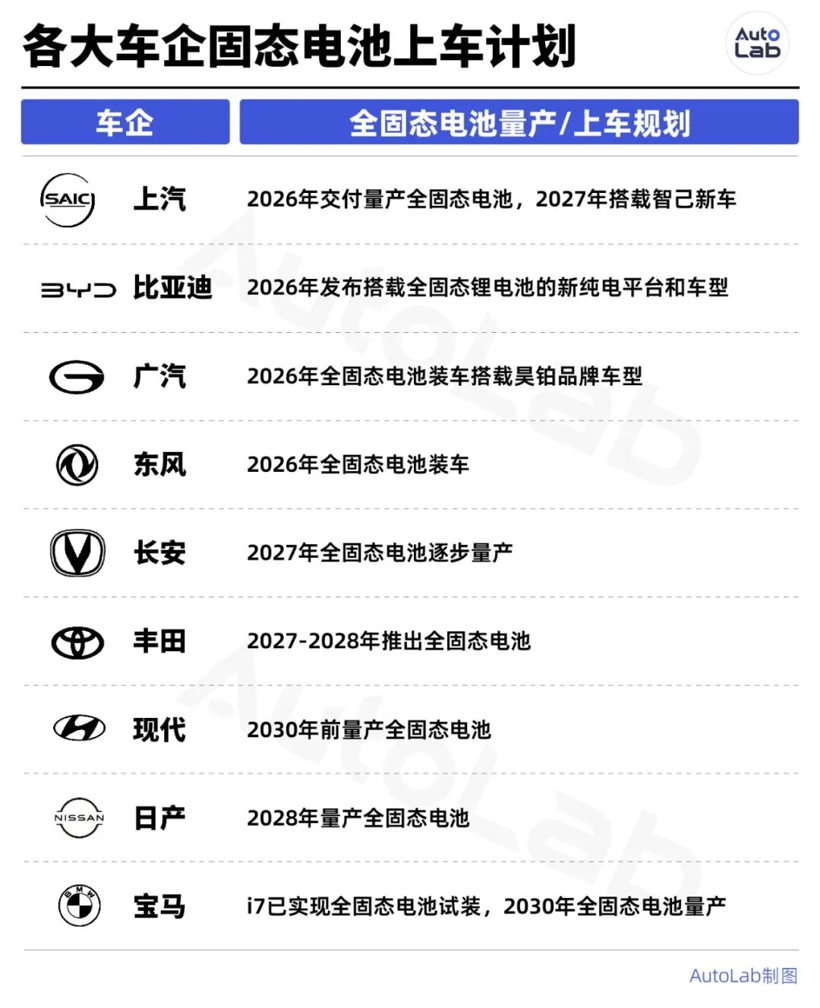Semi-solid batteries forced to renamed? just started, facing obsolescence crisis
The window for car companies to market semi-solid-state batteries may be about to close.
According to reports from major media outlets, in order to prevent market confusion between solid-state batteries and semi-solid-state batteries, relevant authorities are considering issuing a new document to rename "semi-solid-state batteries" as "solid-liquid batteries."
New energyThe batteries in the car, whether ternary lithium or lithium iron phosphate, are liquid batteries, meaning the electrolyte is in a liquid state.
Correspondingly, solid-state batteries refer to batteries with a solid electrolyte, while semi-solid batteries have mostly solid electrolytes with a small amount of liquid.
The energy density of solid-state battery packs can exceed 500Wh/kg, while achieving 200Wh/kg with liquid-state batteries is already considered relatively high.
In the context of new energy vehicles, solid-state batteries can provide longer range and stronger power. I'm sure many of you have heard quite a bit about solid-state batteries in the news over the past couple of years.
With the endorsement of solid-state batteries, semi-solid-state batteries naturally create an impression of exceptional strength, making them a marketing favorite.
The History of Semi-Solid State Batteries in Vehicles
As early as the end of 2022, Voyah took the lead in the industry by equipping its Zhuiguang model with semi-solid-state batteries.
However, due to the average sales of the, the semi-solid-state battery has naturally not entered the sights of more people.
The first to showcase the strength of solid-state batteries to the public is actually NIO.
In December 2023, NIO Chairman Li Bin drove an ET7 equipped with a 150 kWh battery pack, starting a live-streamed endurance test from Shanghai heading south.
This 150kWh battery pack is the semi-solid-state battery that NIO announced at NIO Day back in 2021, with an energy density of 260Wh/kg.
When this 150kWh battery pack has only 3% of its remaining charge, Li Bin has already driven the ET7 for 1,044 km.
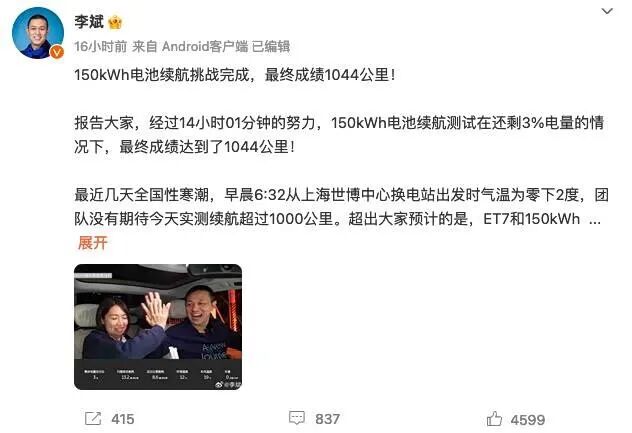
The long-term endurance test concludes here, and for the first time, the semi-solid-state battery showcased its capabilities under the scrutiny of over 800,000 people.
However, compared to the information points about semi-solid-state batteries and 260Wh/kg, the 150kWh battery capacity, which supports the ET7 to travel over a thousand kilometers, is obviously more important. A high energy density primarily ensures that the battery size does not become too large, thus supporting battery swapping.
A notable detail is that NIO President Qin Lihong revealed that the cost of NIO's 150kWh battery pack is equivalent to that of an ET5 vehicle, highlighting the high cost.
NIO's 150kWh battery pack is only available for rent, not for sale, so users actually won't have a high perception of its cost.
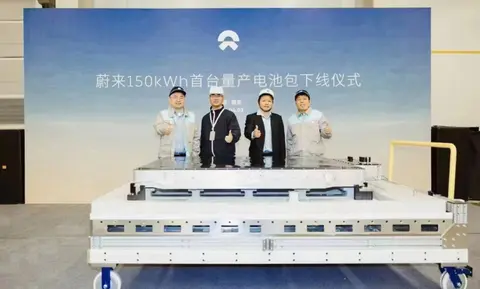
What truly gives users a real sense of the cost of semi-solid batteries is Zhiji.
In May 2024, the Zhiji L6 was launched, with the top model equipped with a semi-solid-state battery, offering a CLTC range of over 1000 km. The price reached 325,900 yuan, which is exactly 40,000 yuan more than the second-highest model that does not have the semi-solid-state battery.
Meanwhile, due to the marketing of solid-state batteries, Liu Tao, co-CEO of Zhiji, had a verbal spat with Zhao Changjiang, former general manager of the sales division at Dengshi.
Although the top configuration of the Zhiji L6 is equipped with a semi-solid battery, both Liu Tao and Zhiji's official promotion refer to it as an "ultra-fast charging solid-state battery."
Zhao Changjiang then posted, stating "Promoting semi-solid automotive batteries at this time is just playing word games."
Liu Tao responded immediately: "Wordplay is not our strong suit; only technological innovation and iteration can drive the progress of the times."
Regardless of whether Zhiqi is playing word games, after more than a year of development, it is indeed the case that SAIC, which supports it, has once again pushed the semi-solid-state battery onto vehicles through technology, and the progress is quite significant.
On August 29th this year, the brand new MG4 was launched, and this time the price is even more affordable. The official guide price is 102,800 yuan for the new MG4 Semi-Solid Anxin Edition, with a range of 530km, and the liquid content of the semi-solid battery is only 5%.
In terms of safety, the all-new MG4's semi-solid-state battery has successfully passed the 10-pin puncture test and the three-way puncture test. Moreover, MG has promised to provide a new car as compensation if the battery catches fire.
It is worth noting that in terms of performance parameters, the version of the new MG4 equipped with a 53.9kWh semi-solid-state battery shows no difference in range, power consumption, or charging time compared to the version equipped with a 53.9kWh CATL lithium iron phosphate battery.
Considering the developments over the past two years, semi-solid-state batteries are still in a very primitive exploratory stage. Despite being labeled as "solid-state," their actual capabilities have not shown a significant difference from the currently widely used liquid batteries.
Solid-state batteries, even though they have not yet been fully integrated into vehicles, seem to be even more fervently pursued than semi-solid-state batteries, appearing almost like an arms race.
Solid-state battery makes another breakthrough.
Solid-state batteries have recently overcome the biggest barrier to becoming practical.
According to a report by Xinhua News Agency, Chinese scientists have successfully overcome the "bottleneck" of solid-state batteries. A 100-kilogram battery, which previously could run a maximum of 500 km, is now expected to exceed 1000 km.
Currently, the commonly used solid electrolyte for solid-state batteries is sulfide, which has a relatively high hardness, while the lithium metal electrode is relatively soft.
Therefore, when these two materials are bonded together, the interface is always uneven, which greatly affects the efficiency of lithium ion movement between the positive and negative electrodes.
The Institute of Physics of the Chinese Academy of Sciences, in collaboration with multiple research teams, has found that iodide ions can attract lithium ions at the interface, filling in the pits and ensuring the efficient movement of lithium ions between the positive and negative electrodes.
At the same time, the Institute of Metal Research of the Chinese Academy of Sciences has also used polymer materials to ensure that the battery remains intact even after being bent 20,000 times or twisted into a pretzel shape.
The research team at Tsinghua University has modified the electrolyte using fluorinated polyether materials, which can prevent high voltage breakdown of the electrolyte and further ensure the safety of the battery.
Certainly, the light boat is still far from sailing past the myriad mountains.
From the laboratory to mass production in factories, many challenges still need to be overcome, such as technology development, improvement of the supporting supply chain, adjustment of production lines, and ramp-up of yield rates, all of which are akin to sparking a revolution in power battery production.
In addition, some car manufacturers have recently disclosed their latest progress in solid-state batteries.
Toyota announced at the beginning of this month that it will launch all-solid-state batteries in 2027-2028.
This means that if Toyota had not made grand promises, the first mass-produced vehicle equipped with solid-state batteries would be less than two years away from now.
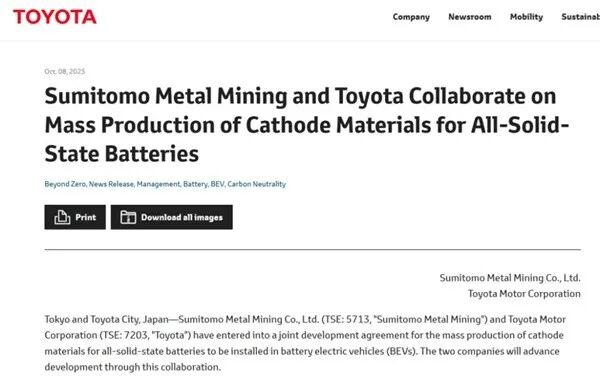
However, those familiar with the plot should remember that the year previously written by Toyota was actually 2026, which has now quietly been pushed back.
Additionally, in September, Mercedes tested a solid-state battery-equipped EQS vehicle, which traveled a total of 1205 km across three European countries without any charging, encountering various climates and road conditions along the way.
Although the car is a test vehicle and the solid-state battery is still in a pre-production state, the potential that solid-state batteries offer is indeed promising based on the performance itself.
Imagining is always easy and beautiful, but whether the reality of the future can be satisfactory is still a big question mark.
Zeng Yuqun, the chairman of CATL, previously stated: "If we use the numbers 1 to 9 to represent the technological and manufacturing maturity of solid-state batteries, the current highest level in the industry is only around 4, as we have only produced some device samples and conducted some experimental validations."
We have also compiled a schedule for when major car manufacturers will implement solid-state batteries, and you can also guess in the comments which manufacturers will be able to "submit their work" on time.
In conclusion
Whether it is semi-solid-state batteries or solid-state batteries, they are still in relatively early stages of development.
In the past two years, solid-state batteries have almost experienced a "deification movement," as if all the problems currently faced by power batteries will be effortlessly resolved once solid-state batteries are mass-produced and used in vehicles, allowing for a worry-free future.
Due to the halo effect of solid-state batteries, semi-solid-state batteries have also gained favorable attention in the market, and have currently achieved initial mass production and application in vehicles.
However, in terms of practical application, despite the fact that semi-solid batteries sound very similar to solid-state batteries, their overall capabilities still have a significant gap compared to solid-state batteries, making it difficult to compare the two.
Therefore, if semi-solid batteries are indeed renamed "solid-liquid batteries," it would be a good thing to standardize market competition and prevent users from being misled by "concepts."
【Copyright and Disclaimer】The above information is collected and organized by PlastMatch. The copyright belongs to the original author. This article is reprinted for the purpose of providing more information, and it does not imply that PlastMatch endorses the views expressed in the article or guarantees its accuracy. If there are any errors in the source attribution or if your legitimate rights have been infringed, please contact us, and we will promptly correct or remove the content. If other media, websites, or individuals use the aforementioned content, they must clearly indicate the original source and origin of the work and assume legal responsibility on their own.
Most Popular
-

List Released! Mexico Announces 50% Tariff On 1,371 China Product Categories
-

Nissan Cuts Production of New Leaf EV in Half Due to Battery Shortage
-

New Breakthrough in Domestic Adiponitrile! Observing the Rise of China's Nylon Industry Chain from Tianchen Qixiang's Production
-

Dow, Wanhua, Huntsman Intensively Raise Prices! Who Controls the Global MDI Prices?
-

Mexico officially imposes tariffs on 1,400 chinese products, with rates up to 50%





